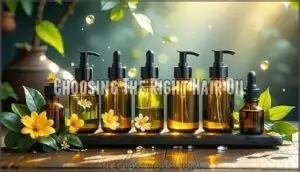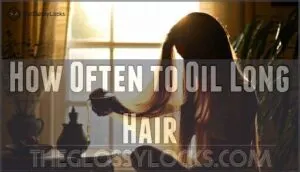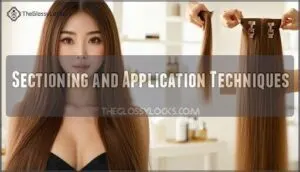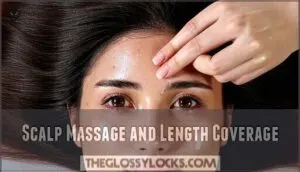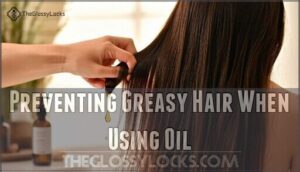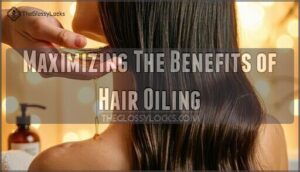This site is supported by our readers. We may earn a commission, at no cost to you, if you purchase through links.
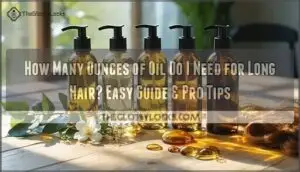
Sometimes a splash brings out glossy waves; other times, your scalp feels like you deep-fried it. The trick lies in matching your oil (and the amount) to your strands’ needs, their thickness, and those sneaky factors like porosity and product buildup.
Nail this routine, and shine, softness, and manageability are finally yours for the taking.
Table Of Contents
- Key Takeaways
- How Much Oil for Long Hair?
- Choosing The Right Hair Oil
- How Often to Oil Long Hair
- Step-by-Step Guide to Applying Hair Oil
- Preventing Greasy Hair When Using Oil
- Maximizing The Benefits of Hair Oiling
- Frequently Asked Questions (FAQs)
- What type of oil is best for long hair?
- Are there any natural alternatives to hair oil?
- How do I know if I’m using too much oil on my hair?
- Is there any way to reduce the amount of oil I need to use?
- Can I use hair oil to prevent split ends?
- Does climate affect oiling needs for long hair?
- What’s the shelf life of most hair oils?
- Are there side effects to using expired oils?
- How do you store hair oil for best results?
- Conclusion
Key Takeaways
- Start with 1–2 tablespoons of oil for long hair and adjust based on your hair’s thickness, porosity, and curl pattern.
- Fine hair needs less oil to avoid buildup, while thick or very long curls may need up to an ounce for healthy moisture and shine.
- Apply oil evenly by sectioning your hair, massaging into the scalp, and smoothing it through to the ends.
- Use lighter oils for fine or oily hair, heavier oils for thick or dry hair, and tailor your routine to how quickly your hair absorbs oil.
How Much Oil for Long Hair?
Figuring out just how much oil to use on long hair can feel like guesswork.
Let’s clear up the confusion so you never end up with greasy roots or dry lengths.
Here’s what you need to know before you get started.
Recommended Oil Amounts by Hair Length
No matter how long your hair is, figuring out the right amount of oil to use can make all the difference between shiny, healthy locks and a greasy, weighed-down mess.
For medium to long hair, start with 1–2 tablespoons; super long or extra thick curls may need up to an ounce.
Let hair porosity and oil distribution guide your hair oil application.
Measuring Oil for Each Application
So you’ve got your oil ready—now let’s figure out just how much to pour into your palm for each session. For medium to long hair, a tablespoon often nails it; super long curls might need more.
Think about the thickness of your oil and how much your scalp tends to absorb.
Using the right amount helps you get all the shine without ending up greasy—now that’s real application finesse.
Adjusting Amounts for Hair Thickness
Once you know your starting amount, the real secret is matching it to your hair’s thickness—because what works for one head won’t always cut it for another.
Fine hair calls for less hair oil; too much leads to product buildup fast. Medium hair gets a little more. Coarse hair, especially with higher porosity levels, drinks up the extra!
Choosing The Right Hair Oil
Finding a hair oil that suits your long hair isn’t always simple, but it makes all the difference. The right one depends on your hair’s texture and how quickly it soaks up oil.
Here’s what to watch for as you pick your perfect match.
Best Oils for Long Hair Types
Ever wonder why some oils do wonders for your friend’s hair but leave yours flat or greasy? It’s all about matching oil absorption rates and porosity considerations to your unique hair type.
For example, Argan oil is a lifesaver if you crave shine and strength, while DIY oil blends or seasonal oil choices can boost scalp oil balance for flexible hair care.
Hair oils can also restore hair elasticity and luster.
Heavy Vs. Lightweight Oils
Whether your hair loves to soak up moisture or shrinks away from anything too rich, choosing the right oil weight can make all the difference in how your locks look and feel.
Heavy oils—like Argan oil—are great for thick or dry hair, but lightweight types of hair oil prevent scalp buildup and suit fine, low-porosity hair.
Think seasonally too!
Oil Viscosity and Absorption
The way your hair soaks up oil depends on the thickness of the oil—and trust me, a little science goes a long way in getting that shine just right. Heavy oil usage means slower absorption, especially for low-porosity hair types, while lightweight oil benefits those with fine strands.
Porosity considerations change everything: if your hair drinks up oil quickly, absorb away!
How Often to Oil Long Hair
Let’s talk about how often you should actually oil your long hair. Different routines work for different hair types, and there’s no one-size-fits-all answer.
Here’s how to find the rhythm that works best for you.
Frequency Based on Hair Type
Wish your hair gave you cues like, “Hey, I need oil!”? Here’s the breakdown:
- Dry Hair or an Active Lifestyle? Oiling two to three times a week is your best bet.
- Oily Scalp or fine hair? Every 10–14 days is plenty.
- Curly Hair? You’ll want to oil more often—moisture slips away fast! To maintain scalp health, consider natural oils application as a pre-shampoo treatment.
Deep Treatment Vs. Routine Oiling
Think of deep oil treatments like a spa day for your hair, while routine oiling works more like your trusty daily moisturizer. Deep sessions feature overnight masks or heat for intensive hydration and major scalp health boosts. Routine oiling keeps things balanced between washes. Here’s how they stack up:
| Treatment Type | When to Use | Pro Benefits |
|---|---|---|
| Deep Treatments | Every 1–2 weeks, overnight | Intensive Hydration, Repair |
| Routine Oiling | 1–3x per week | Scalp Health, Shine |
| With Heat | Monthly | Enhanced Absorption |
| No-Heat Routine | Weekly | Gentle, Low Buildup |
| All-in-One Blend | Biweekly | Balanced, Easy Maintenance |
Signs You’re Oiling Too Often
You know you’ve crossed the line with oiling when your hair feels more like a salad than a style. Watch out for these four red flags:
- Greasy buildup that won’t budge, no matter how often you shampoo.
- Scalp irritation or itching.
- Limp hair lacking volume.
- Product incompatibility or dullness increase despite your best hair care tips.
Step-by-Step Guide to Applying Hair Oil
Ready to put hair oil to work? Here’s how to make each step count for long, healthy hair.
Let’s break it down so you get the best results every time.
Sectioning and Application Techniques
Ever try painting a wall without taping off the edges first? That’s what oiling your hair without proper sectioning can feel like.
Divide your hair into four or more sections for targeted treatment and even oil distribution. This layered application boosts scalp coverage, but also improves product absorption—making hair oiling techniques more effective from root to tip.
Scalp Massage and Length Coverage
Once your hair’s sectioned, it’s time to put those fingertips to work—massaging oil into your scalp and gliding it all the way down, so every inch gets a little love.
Gentle scalp massage techniques trigger scalp stimulation and encourage root health, while slow, even distribution means every strand benefits from better oil penetration and moisture. Think of it as a spa day for your hair.
Timing and Duration for Best Results
Now that your scalp and strands are feeling pampered, let’s talk about how long to let the magic work before you rinse. For the best oiling time, consider these tips:
- Leave oil on for 1 hour (quick boost)
- Overnight benefits for deep repair
- Try heat application for extra absorption
- Stick to a consistent routine
It’s all about finding what works best for your hair!
Preventing Greasy Hair When Using Oil
No one wants limp or oily hair after using hair oil. The secret is all in how you apply and care for your hair after oiling.
Here’s what to know so you keep the shine, not the grease.
Tips for Avoiding Over-Application
Before you go pouring oil like you’re dressing a salad, let’s chat about how a little really does go a long way.
Less Is More—use just a nickel-sized amount to avoid scalp buildup. Focus on effective Application Methods and Oil Distribution.
Try product dilution or emulsifying between your hands. That’s the secret behind using hair oil effectively!
Proper Washing After Oiling
After you’ve worked that oil in just right, getting it all out takes a gentle touch and the right wash routine. Start with lukewarm water—never hot. Massage your scalp using careful shampoo techniques to lift away product buildup.
Follow with conditioner on your ends. Pat dry instead of rubbing to keep your hair looking healthy and shiny. That’s smart hair care!
Best Practices for Fine or Oily Hair
If your hair gets oily faster than a slice of pizza at a summer picnic, don’t worry—keeping those roots fresh just takes a lighter hand and a few smart moves.
- Use only lightweight formulas—heavy oils overwhelm short or fine hair.
- Limit your application to mid-lengths and ends.
- Improve washing techniques to nix scalp buildup and boost Oil Absorption Rates.
Maximizing The Benefits of Hair Oiling
You’ve mastered the basics of hair oiling, but there’s more to discover from your routine. Getting the most out of your oil treatments means understanding how they work with your other products and building habits that actually stick.
Let’s explore three key strategies that’ll transform your oiling game from good to absolutely wonderful.
Improved Shine, Strength, and Manageability
Ever wondered why your hair never quite shines the way you wish? The right hair oil at the ideal dosage is key to enhanced brightness, strong strands, and knack for managing frizz before it ever spirals out.
Here’s how the benefits of hair oil show up:
| Benefit | Real-World Result |
|---|---|
| Hair Elasticity | Less breakage |
| Enhanced Brightness | Noticeable, healthy shine |
| Frizz Reduction | Smooth, touchable texture |
| Damage Protection | Resilient, safer strands |
| Hair Manageability | Easier styling every day |
Combining Oil With Other Hair Care Products
Mixing a little oil with your favorite products is like giving your hair care routine a secret superpower.
For example, try these easy upgrades:
- Add oil and shampoo for gentle cleansing and shine.
- Blend oil and conditioner for extra slip.
- Use oil and masks for deep hair treatment.
- Seal styling with a touch of leave-in oil.
Building an Effective Hair Oil Routine
Finding your sweet spot with oiling is almost like learning the perfect recipe—just the right steps, adapted to your hair, can make all the difference. Consistency is key. Build your hair care routine around your Hair Type, scalp health, and Product Synergy. The true Oiling Benefits shine brightest when oiling becomes a joyful ritual, not a chore.
When hair oiling becomes a joyful habit tailored to your hair, consistency transforms it into real beauty magic
| Routine Step | What You’ll Notice | Why It Matters |
|---|---|---|
| Scalp Massage | Boosted growth | Scalp Health |
| Length Coverage | Smooth strands | Oiling Benefits |
| Weekly Ritual | Less breakage | Routine Consistency |
| Blend with Masks | Deep nourishment | Product Synergy |
| Choose Wisely | Happy hair | Hair Application Magic |
Frequently Asked Questions (FAQs)
What type of oil is best for long hair?
Picture a ’90s stereo—some oils deliver a bass boost, others sing sweet treble.
For long hair, argan oil, coconut oil, and botanical blends shine, depending on your hair porosity and scalp oil production.
Are there any natural alternatives to hair oil?
Try DIY hair masks with aloe vera or shea butter, herbal infusions, or natural oils like Argan Oil, Coconut Oil, Olive Oil, Sweet Almond Oil, or Jojoba Oil—even a touch of essential oils.
How do I know if I’m using too much oil on my hair?
Greasy roots and limp lengths waving back at you? That’s classic Oily Hair Signs. Product Buildup or itchy Scalp Issues mean your hair oil routine’s gone overboard—time to rework application errors for healthy, bouncy texture.
Is there any way to reduce the amount of oil I need to use?
Try applying hair oil to damp hair for better Oil Absorption Rate.
Tweak your Hair oiling techniques—focus on the ends, not roots.
Using concentrated oils or improving Scalp Health and Hair Porosity can stretch each session further!
Can I use hair oil to prevent split ends?
Split End Prevention is like building a safety net at the ends of your rope—hair oil cushions against breakage, locks in hair moisture, and boosts hair shine.
For real results, Oil Type Matters and Application Techniques play starring roles.
Does climate affect oiling needs for long hair?
Seasonal humidity, UV exposure, temperature effects, and aridity impact all play a part in your hair oil needs. More sun or wind damage? You’ll want extra oil to protect hair moisture and combat frizzy or dry hair.
What’s the shelf life of most hair oils?
Most hair oils last 12–24 months, but expiration dates depend on storage impact and ingredients. Rancidity signs—smell, color change—mean it’s time to toss.
Natural preservatives and cool, dark storage help extend shelf life.
Are there side effects to using expired oils?
Dryness rises, shine drops, and stubborn scalp irritation might follow. Expired oil risks include rancidity effects, bacterial growth, or reduced efficacy.
Damaged hair, unexpected breakage, and a real setback for anyone serious about hair health and care.
How do you store hair oil for best results?
Keep hair oil in a cool, dark spot—heat and sunlight speed up oil degradation. Use an airtight glass container.
By storing your oil this way, you’ll help it last longer and keep all those nourishing benefits in your hair care routine.
Conclusion
Silky strands, stunning shine, and smart oiling—that’s the sweet spot. The secret isn’t just how many ounces of oil you need for long hair, but how you read your hair’s signals and respond.
Glide your fingers through, look for gloss, and trust your touch. When you get it right, frizz flees, dryness disappears, and you finally feel like your hair loves you back. That’s more than routine—it’s a small act of everyday confidence.

